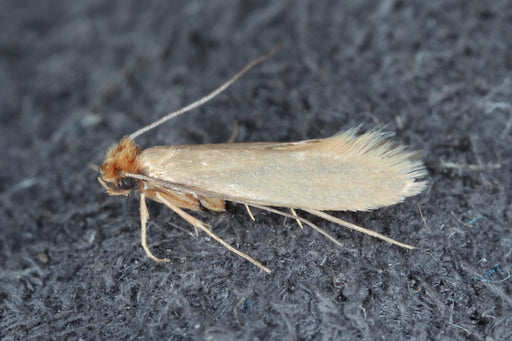Do Moths Eat Cotton Clothes

No one wants to discover a cluster of little holes in their favourite t-shirt. Indeed, uncovering moth damage is pretty much always a disappointing experience. That’s why taking measures to keep moths out of your home is a must.
As you embark on your journey of moth prevention, you may find yourself wondering, do Clothes Moths eat cotton? And if so, what can be done to keep your favourite, breathable cotton apparel items safe? Those seeking answers have certainly come to the right place. Although moths are pesky, winged nuisances and a common problem in homes all over the world, there are plenty of ways to keep your clothes, cotton or otherwise, safe.
To simplify things, we’ve created an in-depth guide that answers the question “Do moths eat cotton clothes” comprehensively. We’ll also discuss the moth prevention process and much more so that you’ll be able to proceed confidently with your moth-proofing efforts. Let’s dive in!
Do Clothes Moths Eat Cotton?
So, do moths eat cotton clothing? Unfortunately, the answer to this question is not a simple yes or no. Adult moths aren’t the culprits when it comes to holes in your clothes, either. Instead, their larvae are to blame. Primarily, Clothes Moth Larvae eat fabrics that contain keratin, a protein-rich substance found in animal based fibres like wool, fur, silk, cashmere, feathers, etc.
Since cotton is a plant-based fibre instead of an animal-based fibre, it usually won't be on the menu for Clothes Moth Larvae. However, there are some exceptions to this. For instance, soiled clothes or fibre blends (especially ones that contain wool) could very well be targeted by hungry moth larvae. Moreover, different kinds of pestilent moth larvae (like Pantry Moths) have been known to tunnel through all kinds of materials in search of food.
Understanding the life cycle of Clothes Moths is a key part of keeping them out of your closets, wardrobe, and storage rooms. Knowing which clothing items are most vulnerable to moth damage can also help. This article covers why moths eat clothes, what their life cycle is like, and much more.

Understanding What Moths Eat
Not all moths will eat your clothes. For instance, Pantry Moth Larvae prefer grains, especially dry grains like flour, oats, barley, and cereals. Nevertheless, Pantry Moths have been known to damage certain types of fabrics.
Still, Clothes Moths are usually to blame for tiny holes and unsightly bare patches in your fine clothing. Specifically, the larvae of the Clothes Moth will hatch and begin chewing through the nearest animal-based, fibrous protein, or keratin-saturated thread source they can find.
So what's on the menu for Clothes Moths, anyway?
This can depend on many factors. Clothes Moths will happily annihilate your favourite cashmere sweater or gnaw through a wool blazer. But do moths eat cotton sweaters? If a sweater contains protein-rich fibre mixes or is soiled by organic particles, it could definitely be damaged by hungry moth larvae.
Clothes Moths Prefer Animal Fibres, But That Doesn’t Always Mean Cotton is Off-Limits
It’s true that Clothes Moth Larvae broadly prefer pure animal fibres like wool, alpaca, cashmere, fur, leather, silk, angora, cashmere, and so on. However, they can still cause significant damage to other materials nearby. This includes plant fibres like cotton, jute, and hemp.
After all, Clothes Moth Larvae eat materials like feathers and leather. So, they can chew through anything they set their hearts on. Whether your cotton clothes get damaged in the melee will largely depend on the circumstances of the specific situation.
Factors That Can Impact Clothes Moths Eating Cotton
Factors that impact whether pesky moths will damage your cotton items include how hungry the larvae actually are, whether the cotton is soiled or saturated with oils, the severity of an infestation, and whether the cotton clothes are near other animal fibre items. Let's go over these factors one by one so that you can better understand why Clothes Moths might damage cotton items.
Are the cotton clothes soiled, stained, or saturated with any oils?
Clothes Moth Larvae will tunnel through essentially anything that contains digestible proteins, and they aren’t very picky about what they munch on. This means that soiled items are often damaged by hungry moth larvae. Even if a sweater is made of 100% cotton plant fibres, it could be at risk for damage if it is soiled or saturated with oils.

This means that if a dirty sweater accidentally gets put away in your closet, it could be damaged and filled with holes as the larvae gnaw the oily particulate matter off of its fibres. Moreover, if any cotton items are soiled with sweat, oils from the skin, food stains, or even faecal matter or urine, they could become a target for the hungry moth larvae. It’s gross we know, but it’s the truth.
How hungry/desperate are the larvae and how close are the cotton clothes to other animal fibre articles?
Although cotton and plant-based fibres are rarely the primary targets for Clothes Moth Larvae, they can nonetheless become damaged if the situation presents itself. Clothes Moth Larvae aren't exactly culinary experts. Their primary objective is to seek out edible keratin fibres and eat through them as quickly as possible as they grow and pupate. If a preferred food source becomes scarce, larvae could very well sample any nearby clothing articles, including those made of cotton. Or, if the cotton clothes are near leather or wool clothing, they could become unintended casualties of ravenous moth larvae.
Which material blends are present?
Are your cotton clothing items blended with other materials like silk, wool, leather, etc? These days, most cotton clothes contain a polyester blend. Polyester is of little to no interest to moths. In fact, moth larvae will eat around the plastics and synthetic fibres and leave behind a strange grid of shredded materials in some cases. However, moth larvae will happily still chew up any animal-based fibres that are blended with plant fibres or synthetics in a garment.
Understanding and Identifying Moths that Eat Fabrics
When you start investigating whether Clothes Moths eat cotton, you will generally find many sources saying that Clothes Moths mainly prefer animal fibres like silk, cashmere, or wool. You’ll also likely read that these moths will only occasionally damage cotton garments if they are soiled or blended with animal-based fibres. That’s all fine and well if you are only dealing with Clothes Moths. However, there are a few other types of moths that will damage fabric items if given the opportunity.
Knowing what kinds of moths you may be dealing with can help you properly store items and protect your home. Otherwise, you could be left thinking that your belongings are safe, only to find them riddled with holes or otherwise damaged later on.
What types of moths will eat fabrics?
Moths that commonly damage fabric items in homes include Clothes Moths, Pantry Moths, and Carpet Moths. Let’s go over what to expect from each of these moths respectively and how to correctly identify them. That way, you will better be able to prevent possible pest problems or the destruction of your cotton items.
About Clothes Moths

The two most common kinds of Clothes Moths are Case Bearing Clothes Moths and Webbing Clothes Moths. Clothes Moths are either brown or silvery grey in colour, and may also have speckled wings for camouflage. The wings of the Clothes Moth come together to make an a-framed shape behind their heads. They have fore and hind wings with a fringe along the margins.
Both Case Bearing/Casemaking and Webbing Clothes Moths are weak flyers and measure less than half of an inch in length when fully grown. The larvae of a Clothes Moth may be white, tan, or brown. Case Bearing Clothes Moths leave behind casings while Webbing Clothes Moths leave behind web-like debris. The larvae of these moths are responsible for causing damage to fabrics as they eat and grow. Both types of moths prefer dark, undisturbed places in the home. Unlike some other kinds of moths, Clothes Moths are not attracted to light.
Primarily, Clothes Moth Larvae feed on animal-based fibres such as leather, silk, feathers, cashmere, angora, wool, and fur. However, in a pinch, these moths may also go after organic materials and plant-based fibres such as cotton or hemp, especially if these materials are soiled with edible oils (even from sweat or bodily fluids) or other stains from food particles.
About Pantry Moths
Pantry Moths, otherwise called Indian Meal Moths or Grain Moths, often infest areas where dry food goods are stored. However, this does not mean that they won't damage fabrics. Pantry Moths have been known to consume or chew through a wide range of materials including paper and wicker. If food sources are scarce, Pantry Moth Larvae will go after anything saturated with edible oils. This could even include lint, scraps of garbage, or dust. Moreover, Pantry Moth Larvae can be relentless in their search for food. As such, storing items in fabric tubs or wicker baskets will not keep them safe from the ravenous larvae of the Pantry Moth.

The easiest way to identify an adult Pantry Moth is by its unique two-toned wings. The front half of the wing will be a light, cream colour, and the back half will be a darker shade of bronze or brown. The larvae resemble small worms and may leave silky spider web-like traces behind in your food or in the corners of food packaging.
About Carpet Moths
Carpet Moths often leave behind threadbare patches on rugs, furniture, or carpets that contain wool or natural animal fibres. These moths have frayed, tattered wings and long antennae. Carpet Moths are smaller than other kinds of house moths and have bodies that are about 5 mm long.
Usually, Carpet Moths are a buff tan or beige colour with forewings that have distinctive dots. Carpet Moth Larvae only eat keratin and natural animal-based fibres. These moths are not known to eat synthetic fabrics or cotton. However, if you have cotton and wool blends or other plant-based fibres that are heavily soiled, they could be prone to Carpet Moth damage.
FAQs on Moth Prevention and Whether Moths Eat Cotton
When holes in garments are discovered, Clothes Moths are usually to blame. However, there are a few other types of moths that can cause damage to your clothes as well. To thoroughly protect your cotton clothes from moths, you will want to understand why Clothes Moths infest homes, what they can consume, which kinds of moths are most likely going to damage your clothes, and of course, how to protect your cotton blends. Here are some frequently asked questions on whether moths eat cotton.
Why do Clothes Moths infest houses?
Female Clothes Moths infest homes in search of a suitable place to lay their eggs. Once the eggs hatch, larvae emerge and begin eating nearby animal-based fibres for sustenance. The larvae grow, go through metamorphosis, and then continue the infestation cycle.
Do moths eat 100% cotton?
Do moths eat cotton clothing? Generally, no. Especially if it is made of 100% cotton. However, they are definitely capable of causing damage to cotton in their quest for another, better food source. Also, if cotton is soiled or blended with natural fibres like wool, it could wind up being damaged. As such, it’s best to store clean cotton garments in safe, moth-free areas. For extra protection, place Moth Traps in spots where you worry moths might visit.

Why do moths eat cotton?
The larvae of Clothes Moths will eat cotton if it has become soiled with food particles, saturated in oils, or contaminated with proteins by any other means. Additionally, moth larvae will consume cotton when it is blended with animal-based fibres including wool and silk.
What fabric do moths not eat?
Moths tend to avoid synthetic materials like polyester, modal, nylon, gore-tex, neoprene, and spandex. With that being said if these materials are blended with natural animal fibres like wool, silk, or cashmere, (and they often are) moths can still cause damage to garments as a whole in their quest to consume the integrated keratin-rich proteins.
Do moths eat cotton T Shirts?
Usually, moths will not bother with your cotton T-shirts. However, if a t-shirt is soiled, saturated in tasty oils, or stained with protein-containing particles (like from food or sweat), moth larvae may indeed go after a t-shirt. To prevent this, always store your clothes after they have been washed and dried thoroughly. If you are worried about moths getting into your closet or any other space, Clothes Moth Traps can also be incredibly helpful.
Can moths eat linen?
Many people do not know that certain kinds of moths are capable of destroying linen fabrics. The larvae of Pantry Moths and Clothes Moths can both do damage to woven materials, stored items, and fabrics. Clothes Moth Larvae may seek out soiled, oily, or food-stained linens such as tablecloths or curtains. Similarly, Pantry Moth Larvae have been known to destroy a range of materials, including the flax-based textile, linen.
Do Wax Worms damage clothes?
Waxworms are the larvae of the Wax Moth and have been known to chew through a range of substances, including drywall. While they do not feed on these materials, they can tunnel through them and cause damage. Generally, Wax Moths damage beehives, so they won’t usually go after your clothes. However, they are known to seek out areas that are dark, poorly ventilated, and warm.
What moths cause damage to clothes and fabrics?
Many people are under the impression that Clothes Moths are the only pests that can damage clothing items and fabrics. While it is true that Clothes Moths are usually to blame for damage to your garments, there are a few other kinds of moths that can be destructive to fabric materials. Other destructive moth species include Pantry Moths, Waxworms, and Carpet Moths.
About MothPrevention
MothPrevention® speak to customers every day about their clothes moth issues - clothes moths are a species that are ever increasing and that can cause significant damage to clothes, carpets and other home textiles.
To date, we’ve helped over 250,000 customers deal with their moth problems. We have developed professional grade solutions including proprietary pheromones and trap design engineered to the highest production standards.





